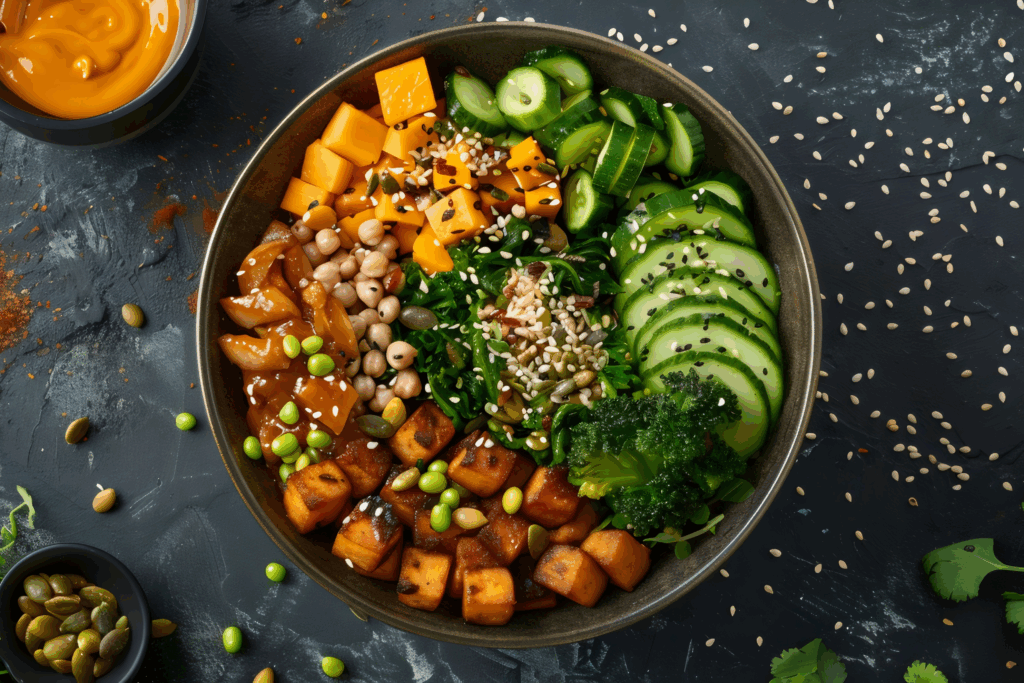In Ayurveda, food is medicine. Each of the six tastes (rasa) — sweet, sour, salty, pungent, bitter, and astringent — carries qualities that shape digestion, mood, and energy. By including all six in daily meals, you create balance on the plate and within yourself.
More Than Just Flavour: Understanding Ayurvedic Taste
The word “taste” in Ayurveda doesn’t mean just the flavour you notice on your tongue. Each rasa reflects the five great elements (ether, air, fire, water and earth) and their qualities which make up food and the body.
Sweet is not only sugar — it is the heavy, nourishing, grounding quality of earth and water, found in rice, wheat, oats, milk, butter, ghee, root vegetables, and dates.
Sour is more than lemons — it is the sharp, moist, stimulating quality of earth and fire, present in citrus fruits, yogurt, cheese, tomatoes, vinegar, wine, and fermented foods like kombucha.
Salty is not just table salt — it is the softening, hydrating, warming quality of water and fire, carried in sea salt, miso, soy sauce, seaweed, and celery seed.
Pungent is more than chili heat — it is the hot, sharp, light quality of fire and air, found in ginger, garlic, onion, mustard, black pepper, coffee, and strong teas.
Bitter is not only romaine — it is the cooling, cleansing, light quality of air and ether, found in leafy greens, herbs like turmeric, dandelion, burdock and yarrow, cocoa, and bitter melon.
Astringent is not simply dryness in the mouth — it is the contracting, toning quality of air and earth, present in legumes (beans, lentils, chickpeas), pomegranate, cranberries, green tea, and broccoli.
This way of looking at food helps us see beyond “good” and “bad” to understand how different tastes act in the body, when they balance and when in excess or deficiency they contribute to dis-ease. Looking at your cravings from a perspective of healing and qualities rather than impulse and compensation, can be a very powerful step in self-care and natural healing.

Learning the Art of the Six Tastes
Most foods also belong to more than one category. Mung dal, for instance, is both sweet (nourishing, grounding) and astringent (drying, toning). Chocolate can be sweet (sugar), bitter (cocoa), and pungent (stimulating). Recognizing these overlaps makes cooking more intuitive and eating more mindful.
SWEET (Madhura)
Sweet in Ayurveda is more than desserts or sugar — it’s the grounding, nourishing energy of earth and water. You taste it in the stability of grains, the creaminess of milk, and the sweetness of root vegetables.
Elements: Earth + Water
Qualities: Cooling, heavy, grounding, nourishing, calming
Balances: Vata, Pitta
Aggravates: Kapha in excess
Examples:
Carbohydrates like rice, oats, pasta, bread, barley, quinoa.
Dairy like milk, cream, butter, ghee, fresh yogurt.
Vegetables such as sweet potato, carrots, beets, peas.
Fruits like bananas, mangoes, apples, blueberries.
Nuts and seeds like almonds, cashews, pecans, pine nuts, sesame, sunflower, nut butters.
Dried fruit and baking items such as dates, raisins, cane sugar, flour, vanilla.
Sweeteners like maple syrup, honey, molasses, coconut milk.
SOUR (Amla)
Sour is more than the taste of a lime wedge — it’s the lively, stimulating energy of earth and fire that awakens the senses and digestion. You find it in citrus, tomatoes, yogurt, and fermented foods.
Elements: Earth + Fire
Qualities: Warming, oily, light, moistening, stimulating
Balances: Vata
Aggravates: Pitta, Kapha
Examples:
Dairy like yogurt (soured), aged cheeses, goat cheese, feta.
Fruits such as oranges, lemons, limes, pineapple, juice.
Vegetables like tomatoes, fermented vegetables (pickles, sauerkraut).
Condiments like vinegar, mustard, miso, chutney, salsa.
Beverages like kombucha, beer and wine.
SALTY (Lavana)
Salty isn’t only table salt — it’s the moist, softening quality of water and fire that enhances flavor and supports hydration. Beyond salt itself, it’s in seaweed, miso, soy sauce, and salted cheeses.
Elements: Water + Fire
Qualities: Heavy, moistening, warming, softening
Balances: Vata
Aggravates: Pitta, Kapha
Examples:
Carbohydrates like salted breads, pasta dishes
Dairy such as salted butter, feta, aged cheeses.
Vegetables like celery, seaweed.
Condiments such as soy sauce, miso, pesto, pickles, salsa, chutney.
Snacks like salted nuts and chips.
PUNGENT (Katu)
Pungent is more than hot sauce — it’s the burning and dry quality of fire and air that clears stagnation and sparks digestion. You encounter it in onions, garlic, mustard, coffee, and everyday spices.
Elements: Fire + Air
Qualities: Hot, sharp, light, dry, stimulating
Balances: Kapha
Aggravates: Vata, Pitta
Examples:
Vegetables such as onion, garlic, radish, mustard greens.
Herbs and spices like ginger, cumin, coriander, fennel, cinnamon, cloves, nutmeg, basil, mustard.
Condiments like mustard, spicy salsa.
Beverages such as coffee and strong teas.
Other foods like dark chocolate (sweet + bitter + pungent qualities).
BITTER (Tikta)
Bitter is more than the strong taste of dandelion or coffee — it’s the cool, cleansing quality of air and ether that lightens and detoxifies. You find it in greens, herbs, cocoa, and teas.
Elements: Air + Ether
Qualities: Cooling, light, dry, clarifying, detoxifying
Balances: Pitta, Kapha
Aggravates: Vata
Examples:
Grains such as quinoa and buckwheat.
Vegetables like leafy greens (spinach, chard, kale, seasonal), cucumber, celery, bitter melon.
Fruits like grapefruit and unsweetened cranberries.
Herbs and spices like turmeric, fenugreek, parsley, lavender.
Other foods like cocoa, dark chocolate, green tea.
ASTRINGENT (Kashaya)
Astringent is more than a glass of wine — it’s the contracting, toning quality of air and earth that tightens and firms tissues. It appears in legumes, pomegranate, green tea, and cruciferous vegetables.
Elements: Air + Earth
Qualities: Cooling, dry, rough, contracting
Balances: Pitta, Kapha
Aggravates: Vata
Examples:
Carbohydrates like barley, millet, buckwheat.
Legumes like lentils, chickpeas, split mung dal (also sweet).
Vegetables such as broccoli, cauliflower, green beans, lettuce, artichokes.
Fruits like pomegranate, apples, pears, unripe bananas.
Dried fruit such as cranberries and raisins.
Other foods like tea (black, green) and cacao nibs.

The Myth of Positive v. “Negative” Foods in Ayurveda
Ayurveda does not judge food as good or bad. Instead, it asks: What are the qualities, and how do they interact with you right now — in your body, mind, and even your emotional patterns?
Sweet foods (rice, ghee, dates) are calming and grounding — but too much becomes heavy or congestive.
Sour foods (yogurt, wine, vinegar) stimulate appetite — but excess creates heat or acidity.
Salty foods (cheese, chips, soy sauce) soften and hydrate — but overdo it and they feel bloating or damp.
Pungent foods (coffee, garlic, chili) warm and stimulate — but in excess they dry, deplete, or overstimulate.
Bitter foods (greens, cocoa, turmeric) cleanse and clarify — but too many can strip or weaken.
Astringent foods (beans, tea, pomegranate) tone and firm — but too much feels rough, drying, or constipating.
It’s not only what you eat but how, when, and how much that determines whether a food is supportive or disturbing.
How to Work with The Six Tastes
A balanced meal is a creative symphony: rice or oats for sweet, lemon or tomato for sour, a pinch of salt, ginger or cumin for pungent, a side of greens for bitter, and legumes for astringent. Together, these six tastes are the foundation of “food as medicine” and are the key to a harmony of nourishment, digestion, and elimination for the body and grounded clarity for the mind.
Look for guidance through Ayurvedic Wellness Coaching to deepen your personal understanding of the Six Tastes and how to use this wisdom for easy and natural healing.


